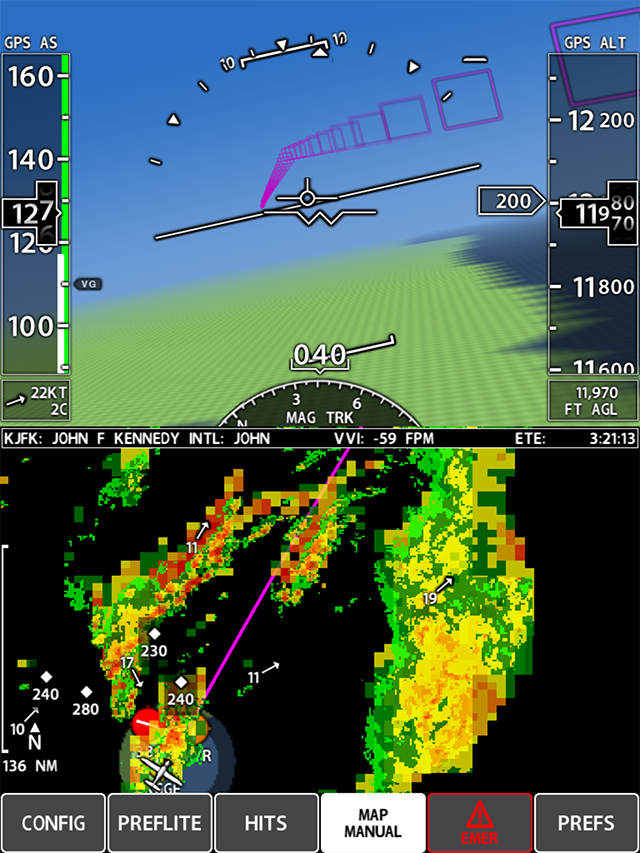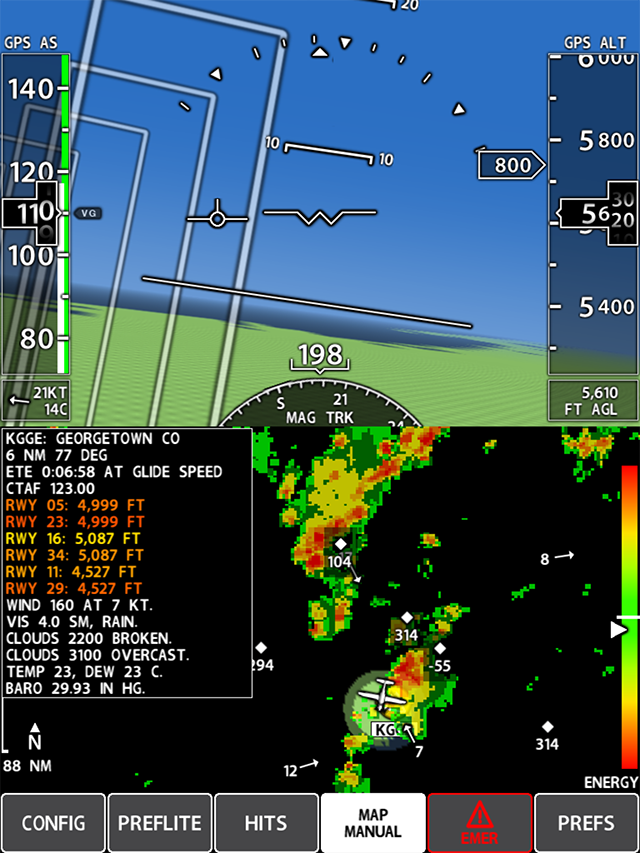(See Xavion with ADS-B weather here)
Supported Hardware
Xavion currently works with all iPhones and iPads that are iPhone4 or later, iPad2 or later.
Running on an iPad or iPhone with NOTHING else (simplest!)
You can run Xavion on an iPad or iPhone with no other external devices, if that iPad or iPhone is one of the units that has an internal GPS. But, in that case, the iPad should be fixed to the airplane in some way. MyGoFlight sells a number of really nice mounts. If you have no panel space or do not want to mount an iPad on your panel, then you can run Xavion on your iPhone as well! Just hold your phone in front of you for reference, if needed, to follow Xavion down to safety. This solution is not as good as a mounted iPad, but it could sure still help you out in an emergency! Xavion must be running for the duration of the flight, though: You can not turn it on right after a loss of instruments or engine and get an instant solution. Xavion takes a few moments to lock onto its attitude and the best airports to glide to, so, like any other avionics, Xavion should be running for the entire flight, and not just turned on after an emergency starts. In metal airplanes, an external GPS or ADS-B receiver with built-in GPS is recommended (see below).
ADS-B Receivers (best!)
To really push Xavion and your iPad or iPhone to the limit, though, you need a new ADS-B receiver that offers GPS and attitude as well, and here is the latest info on them:
We now support the L-3 LYNX system. This is really absolutely amazing hardware because it is installed in the cockpit, not a portable unit that might slip off the dash or have it’s batteries go dead in flight. The Lynx broadcasts ADS-B in the GDL-90 format, which lets Xavion and many other apps receive this ADS-B data in the cockpit and use it for weather and GPS input. So, the L-3 Lynx looks to be absolutely amazing for driving Xavion in the cockpit.
Now, if you do NOT have the Lynx installed or do not want to get it, then let’s go onto the plethora of PORTABLE receivers that will also do a great job! (Just try to secure them in the cockpit and be sure their battery is charged!) We currently support the iLevel, Sagetech Clarity, Dual XGPS-170, Dual XGPS-190, Stratux, SkyDemon, PING, and SkyRadar ADSB receivers. These receivers send NEXRAD data to Xavion, which Xavion then uses to plot NEXRAD imagery on the map for you, making it very clear where to NOT go. As well, they send ADSB TRAFFIC data, making it clear where to not EXACTLY go. 😉 These receivers also send winds-aloft data to Xavion, which Xavion then uses to plot winds aloft on the map, making it easy for you to select your optimum cruise altitude. Xavion uses the winds aloft data to plan more accurate power-off glides as well, of course.
Also, these receivers send METAR data for all of the airports that report it. Just touch any airport on the map and it’s METAR instantly appears (…in plain ENGLISH! Not in that confusing line of text and numbers you may be used to). This is the simplest and fastest interface anyone could imagine.
So, these receivers show you traffic, NEXRAD, winds aloft, and METARS. Great! But how does Xavion USE that data to act an an A-I copilot?
Well, as Xavion is constantly running it’s power-off glide simulations to every airport within gliding range, it looks at the METAR for each airport to find the winds at that airport to choose the best runway for you, obviously preferring a headwind and avoiding a crosswind or tailwind. As well, Xavion looks at the ceiling and the visibility to tend towards an airport with better weather, if available. If no METAR is available for an airport, then Xavion estimates winds based on the nearest, lowest, winds-aloft data. Then, once the runway is selected based on the local airport weather, Xavion uses the winds-aloft data to set the steepness of the power-off gliding hoops, so you should be able to make any airport (power-off) that Xavion guides you too, regardless of the wind that day.
So, Xavion shows you traffic, NEXRAD, winds aloft, and METARs.
->Traffic is plotted on the map. (All receivers show all traffic that is reported on the ADS-B ground-transitters, and the Sagetech Clarity shows the 1090 mhz transmissions from the airliners as well).
->Nexrad is plotted visually on the map.
->Winds aloft are plotted visually on the map at the altitude of your choice, and used by Xavion to find the steepness of the power-off glide.
->METARs are shown to you (in PLAIN ENGLISH!) any time you touch an airport, and are used by Xavion to select the best airport and runway for the weather conditions.
So THAT is how Xavion currently shows and uses ADSB weather, and we can tell you from experience: It is AMAZING to see it in flight. Now, the next question many of you have is: What about the Appareo Stratus-2? And the answer is: We can NOT currently support the Appareo Stratus-2, since they have a CLOSED format, and have chosen to work ONLY with ForeFlight! This is a choice made by Appareo, and is beyond our control. Contact Appareo if you would like to see their receiver used for more apps than JUST ForeFlight.
Also, the iLevil, Clarity, and Dual XGPS-190 have little AHRS systems in them that broadcast pitch and roll to Xavion, so you can pass the pad about the cockpit like a map or yoke-mount it while running Xavion on it.
Below, see screenshots taken in flight, using the Sagetech Clarity ADS-B receiver. Note the NEXRAD, winds aloft, traffic, and METAR for the airport in the second shot.
External Gyros and GPS (not as good as ADS-B!)
Right now, the iLevil, Sagetech Clarity, Dual XGPS-170, Dual XGPS-190, Stratux, and SkyRadar ADSB receivers are the bests device to drive Xavion, since they give GPS, ADS-B weather, and traffic (iLevel, Sagetech, and Dual XGPS-190 give attitude as well). But, if you do not want a full ADS-B receiver for some reason, and you are flying in a metal airplane, then you may want an external GPS. iPads and iPhones have been found to deliver useable GPS location in composite aircraft such as the Columbia 400 in which most flight testing was done. Metal airplanes, however, such as the Cessna 172, block the GPS signal to a huge degree. So, if you fly a metal airplane, or want maximum GPS reliability, and do not want an iLevil, Sagetech Clarity, or Dual XGPS-170 or 190 for some reason, then you should buy the Bad Elf GPS for some improvement in the GPS signal (though accuracy is still very marginal in metal airplanes), or the Dual XGPS 150 for greater improvement in GPS reliability in all different types of aircraft (including metal airplanes).
GPS units that have been tested with Xavion include:
- Garmin GLO Bluetooth GPS for iPhone and iPad
- Garmin GNS5870 Bluetooth GPS
- Dual Electronics XGPS150A Bluetooth GPS for iPhone, iPad, and Android
- Bad Elf GPS for iPod touch, iPhone, and iPad
In addition, Xavion should work just fine with any other Apple-certified GPS unit.
Xavion uses the iPads’ internal gyros and accelerometers to determine aircraft attitude in flight, and we typically find accuracy to within about five degrees in flight with the internal sensors alone. A five-degree error may be larger than you want, however, and rapid maneuvering can increase that error temporarily. For more accurate and reliable attitude display, you should get the Levil AHRS-G mini (or the -AW version, which also works fine and does drive pitot-based airspeed) from Levil Technology Corporation to give better attitude indication. If you have the Sagetech Clarity or iLevil, though, then there is no need for any other device, since they provide attitude, GPS, and ADS-B all in one small, wireless, package. If you have the Dual XGPS-170 then it provides ADS-B, but not attitude. If you have the Dual XGPS-190 then it provides ADS-B AND attitude! This is a REALLY nice unit.

